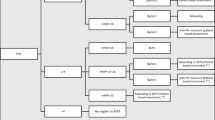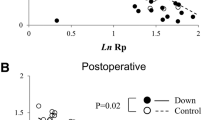Abstract.
The hemodynamic response to pulmonary artery banding (PAB) in relation to the preoperative pulmonary/systemic vascular resistance (Rp/Rs) ratio and to the timing of surgery, with special regard to Down syndrome, was investigated in 56 nonconsecutive pediatric patients aged 3 days to 6 months (mean 2.5 months) with simple and complex congenital shunt-related cardiac malformations. Among the non-Down patient group (39 patients; mean age 6.9 weeks) there was a good hemodynamic response in all but three cases, irrespective of the preoperative Rp/Rs ratio; these three poor responders had preoperatively normal or nearly normal Rp/Rs ratios (Rp/Rs < 0.3) and were affected postoperatively by lung complications. In the Down patient group (17 patients; mean age 8.2 weeks) the mean preoperative as well as the mean postoperative Rp/Rs ratio was higher than in the non-Down patient group (preoperative Rp/Rs 0.49 versus 0.32; postoperative Rp/Rs 0.31 versus 0.18). There was a good hemodynamic response in all five patients with Down syndrome who had preoperative normal or nearly normal pulmonary vascular resistance ratios (Rp/Rs < 0.3). Among 12 patients with Down syndrome and preoperative increased resistance ratios (Rp/Rs > 0.3) PAB did not cause a reduction in pulmonary vascular resistance (PVR) in five patients (postoperative Rp/Rs 0.49–1.00), all operated on at more than 6 weeks of age. PAB resulted in effective reduction of postoperative Rp/Rs ratios (range 0.10–0.27) in seven patients, six of them younger and one older than 6 weeks at the time of the banding procedure. In conclusion, patients with Down syndrome and shunt-related cardiac malformations (predominantly total atrioventricular canal cases) in general have higher pre- and postoperative Rp/Rs ratios than non-Down children and also have a higher potential for developing pulmonary vascular obstructive disease despite hemodynamically effective PAB. Especially in children with Down syndrome and pathologically high resistance ratios, PAB, if indicated, should be performed as early as possible.
Similar content being viewed by others
Author information
Authors and Affiliations
Rights and permissions
About this article
Cite this article
Borowski, A., Zeuchner, M., Schickendantz, S. et al. Down Syndrome as a Factor Influencing Hemodynamic Response to Pulmonary Artery Banding. Pediatr Cardiol 17, 375–381 (1996). https://doi.org/10.1007/s002469900082
Issue Date:
DOI: https://doi.org/10.1007/s002469900082




